

Working 3 stages: How does reverse osmosis work? The rising demand for freshwater and its dwindling supply has been a matter of grave concern over the past many years.

Rising soil and water pollution has only worsened the situation. The fact is that the majority of Indian population today has no access to clear drinking water. This is especially true for the urban and rural poor, people who cannot afford basic water cleaning technology. The public water supply system must step in to make up for this shortage. Clean drinking water is simply too important for a nation’s health and given that many people still cannot afford to install personal cleaning system, a more inclusive public policy is essential. Understanding Reverse Osmosis Reverse osmosis (RO) is a water purification technology. A typical RO plant operation can be divided broadly in three parts —pre-treatment, RO treatment and post-treatment. Pre-treatment: · Stage 1: Removing sediments that is visible to the naked eye, such as sand particles.
Treatment: Post-treatment: - Military. What support is needed for a Reverse Osmosis system? Why Wastewater Treatment is great for people? What is the importance of wastewater treatments? With the headway in innovation, there have been so numerous natural and synthetic wastewater medicines created to address the issues of alkali in wastewater.
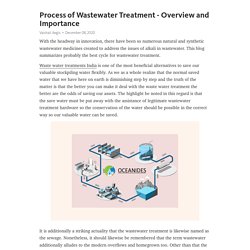
This blog summarizes probably the best cycle for wastewater treatment. How to improve the RO industry for the future of science? An Overview of Reverse Osmosis Plants Systems - Download - 4shared - Divyesh - OceanIdes. What is the principal Reverse Osmosis System? A RO plant or an reverse assimilation plant can be characterized as an assembling plant where the premise cycle of converse osmosis happens.
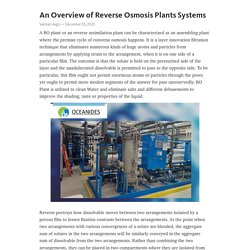
It is a layer innovation filtration technique that eliminates numerous kinds of huge atoms and particles from arrangements by applying strain to the arrangement, when it is on one side of a particular film. The outcome is that the solute is held on the pressurized side of the layer and the unadulterated dissolvable is permitted to pass to the opposite side. To be particular, this film ought not permit enormous atoms or particles through the pores yet ought to permit more modest segments of the answer for pass unreservedly. RO Plant is utilized to clean Water and eliminate salts and different debasements to improve the shading, taste or properties of the liquid. Reverse portrays how dissolvable moves between two arrangements isolated by a porous film to lessen fixation contrasts between the arrangements.
Features: • Stops fluorosis • Inexpensive. Do you know RO plants need pretreatment? Few things if you ignore will affect the RO unit. In this post, suppliers or RO plants India will discuss about common issues that affect membrane water treatment units.

You should know the things that bring problems to your RO plant. The four most common issues will be explained in this article by experts. There are certain things if you ignore will affect your RO unit, such as- · Inadequate training of workforce · Inadequate microbial control · Inadequate monitoring · Inadequate equipment design Inadequate training of workforce The sole major issue in the membrane water treatment industry is that too few people have got professional training. It is not necessary for everyone to have same amount of training. . · Knowledgeable · Advanced. RO technology: What are the driving forces of the rising demand? With an exploding growth in population and deteriorating water supply, India has an ever-growing requirement for clean drinking water.
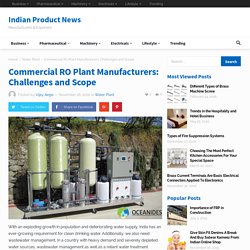
Additionally, we also need wastewater management. In a country with heavy demand and severely depleted water sources, wastewater management as well as a reliant water treatment technology becomes imperative. What to look for in a commercial RO plant manufacturer? What to Look for in Commercial RO Plant Manufacturers: What to Look for in Commercial RO Plant Manufacturers Slide 2: With deteriorating standards in clean drinking water, many people and communities are now looking for autonomous solutions for clean drinking water.
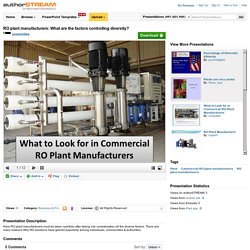
This has become increasingly important as our population explodes, making it impossible for existing water resources to keep up with the demand. How much does a commercial RO system price? With deteriorating standards in clean drinking water, many people and communities are now looking for autonomous solutions for clean drinking water.
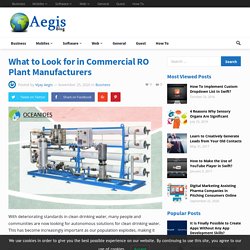
This has become increasingly important as our population explodes, making it impossible for existing water resources to keep up with the demand. The most effective solution here has been commercial RO plant manufacturers. With wide applicability and effectivity in a wide range of environmental conditions, RO solutions are often the most effective. There are many reasons why RO solutions have gained popularity among individuals, communities and authorities. Some of these are: Suitable for desalination.Effective cleaning of water, including filtering of chemicals.Portability of RO systems, making it suitable for individual homes and special situations like military troops.Wide applicability in areas, including areas like the food industry. How to work RO? Working with process. What is the process need for sewage treatment plants? Reverse osmosis was delivered as a water treatment framework more than 40 years earlier.
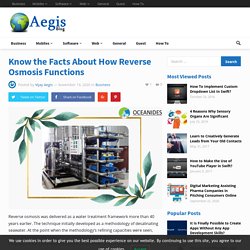
The technique initially developed as a methodology of desalinating seawater. At the point when the methodology’s refining capacities were seen, invert RO structures began to be monetarily made for home water filtration purposes. Such systems were presented in homes as in the 1970s. Invert RO systems seemed a doable decision to the even more unbalanced and imperativeness wasteful refining units.